Our patients will be walking within two hours of the surgery. You can go back to work (depending on your job) whenever you choose to. I have many knee replacement patients back in the office part-time after one week. You can play golf at 6 weeks and tennis at 10 weeks post op in most cases. Our new pain management techniques greatly decrease your need for pain meds!
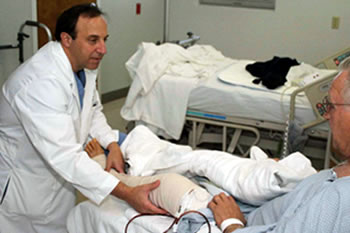
A step-by-step post-operative guide to your recovery
We maximize your knee replacement recovery using pain management techniques and special anesthesia skills. We prefer a regional anesthetic if possible (spinal anesthesia) because it is safer for patients. Other specific benefits to regional anesthesia are: less blood loss, less pain, less nausea, easier surgery ( better muscle relaxation), less blood clot risk post-op, less reliance on IV narcotic meds which have many negative side-effects like nausea, lethargy, light-headedness, itching, and respiratory depression. We also use a femoral nerve block as an additional pain management technique on all of our total knee surgeries. This is an injection of a “novacaine” like drug into the groin pre-op by the anesthesiologist before the spinal goes in. This numbs the femoral nerve, and greatly reduces the pain you feel for up to 36 hours. It also makes the quadriceps muscle weak until the block wears off, so you have to hold on to your walker to prevent a fall.
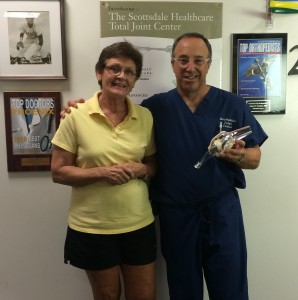
Some patients may have a “general” anesthetic for medical reasons or strong preference. I and many others believe that the spinal patients recover faster, as they have less nausea and less fatigue, and since the pain comes back slowly and gradually, they have less anxiety, fear, and perception of pain. I understand some patients are fearful of being awake during the surgery. Most of the spinal anesthesia patients are still asleep, but using IV sedation, so they continue to breathe on their own ( much preferred to the general anesthesia which necessitates a big plastic tube in your trachea and very strong drugs to paralyze muscles which have a variety of side-effects). We want you to recover as fast as possible – this is better for both of us!
We try to avoid narcotic medications as much as possible. They have side effects of nausea, constipation, and lethargy. They also lead to respiratory depression, particularly in the elderly. We use non-narcotic medications such as Toradol (a strong NSAID like motrin), IV Tylenol, PO Celebrex pill, Ultram, and Naprosyn as well as muscle & anxiety relaxers like ativan, xanax, and librium. Much of the hospital care focuses on pain management and immediate rehab, to get you going fast! It is now possible to do a total knee in a highly motivated patient as an outpatient (sameday) surgery.
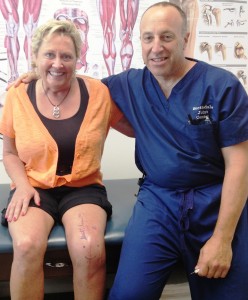
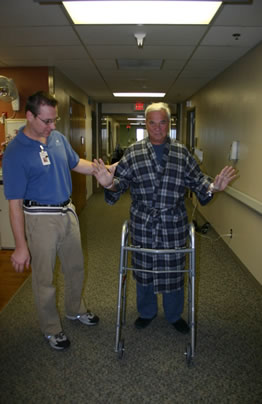 Our patients will be walking on the Joint Center floor ( 6 West at Scottsdale Healthcare Osborn) within two hours of the surgery. This also GREATLY decreases the risk of clotting in the veins. Our DVT rate is less than one percent with this early motion protocol. We also use aspirin, coumadin, or lovenox as a blood thinner, depending on the risks and special circumstances for each patient. Most patients will be discharged on two aspirins a day for 30 days. A foley catheter in the bladder is removed on day one. Some male patients may choose to forego the foley. That is OK, but about 10% will need it inserted later if they have trouble voiding. The foley allows us to measure urine output which is an accurate indicator of overall body function. It is hard for some people to get to the bathroom immediately after surgery, and so it is a matter of convenience as well. (The spinal anesthetic often make it harder to urinate initially!).
Our patients will be walking on the Joint Center floor ( 6 West at Scottsdale Healthcare Osborn) within two hours of the surgery. This also GREATLY decreases the risk of clotting in the veins. Our DVT rate is less than one percent with this early motion protocol. We also use aspirin, coumadin, or lovenox as a blood thinner, depending on the risks and special circumstances for each patient. Most patients will be discharged on two aspirins a day for 30 days. A foley catheter in the bladder is removed on day one. Some male patients may choose to forego the foley. That is OK, but about 10% will need it inserted later if they have trouble voiding. The foley allows us to measure urine output which is an accurate indicator of overall body function. It is hard for some people to get to the bathroom immediately after surgery, and so it is a matter of convenience as well. (The spinal anesthetic often make it harder to urinate initially!).
Once you are home, we encourage home exercises to get your new knee moving. I like to delay formal PT for 4 or 5 days to allow the swelling to go down and the bleeding to stop. We usually do not have problems with patients getting their range of motion with a delayed start ( on the contrary, they do better!). You change your knee dressing at 48 hours (often done in the hospital before discharge). Shower is usually OK right away, but stay out of the pool for a week. If there is any drainage from the knee (usually blood) then it is better to not get it wet. You should call Dr. Kozinn at 480-994-1149 if there is persistent drainage or extraordinary pain post operatively. If you have a high fever ( > 101.5 ) that persists, you should call Dr . Kozinn. We often bring patients in for a wound check within a week of surgery – just to be over-cautious. Small problems (like drainage) can be easily solved early before they become large problems (like infection).
All patients get 24 hours of IV antibiotics to prevent infection. ( Infections are rare, and our infection rate is about 1/200 or .5%, and appears mostly to be a matter of “bad luck”). The most important thing patients can do to prevent infection is to CALL US if there is any wound drainage after they go home. Also avoiding the bath tub and pool is important until the wound is sealed.
Some younger patients will go home on the day after surgery. Most Total knee patients elect to stay an extra day however, as the nerve block wears off and the more “normal” pain returns. Total knee replacement hurts more than a total hip replacement, mostly because of the need to BEND the knee (and repaired quadriceps muscle) as soon as possible. Physical therapy starts in the hospital on the day of surgery. You may bear full weight with the walker. It is rare for patients to go to a nursing home or rehab facility unless they are elderly or frail, or have nobody to help them a little at home.
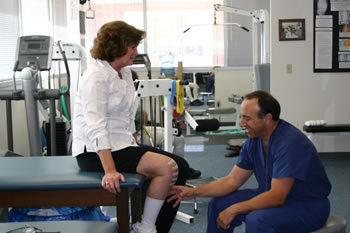 Outpatient physical therapy will be arranged for you at your convenience. We do have our own rehab center here at the Scottsdale Joint Center, and one advantage of doing it here is we are around to keep a closer eye on your progress. You can, however, have PT anywhere in Phoenix that is convenient for you. Most patients stop taking narcotic pain pills after the second week. Motrin and Tylenol work well after that.
Outpatient physical therapy will be arranged for you at your convenience. We do have our own rehab center here at the Scottsdale Joint Center, and one advantage of doing it here is we are around to keep a closer eye on your progress. You can, however, have PT anywhere in Phoenix that is convenient for you. Most patients stop taking narcotic pain pills after the second week. Motrin and Tylenol work well after that.
You can go back to work (depending on your job) whenever you choose to. I have many knee replacement patients back in the office part-time after one week. You can play golf at 6 weeks and tennis at 10 weeks post-op in most cases. You can drive your car when you feel you’re ready, usually one week after a left total knee and three weeks after a right knee surgery. Over 90% 0f patients will be very happy with their new knee. However, it has recently been shown that about 10% of patients still have some reservations about the knee or pain with some activities. We try to lower expectations to some extent, as a TOTAL KNEE is not a normal knee (after all it is a metal and plastic device that your body must adapt to!). I must say that it is my observation that most patients continue to improve for over a year after surgery.
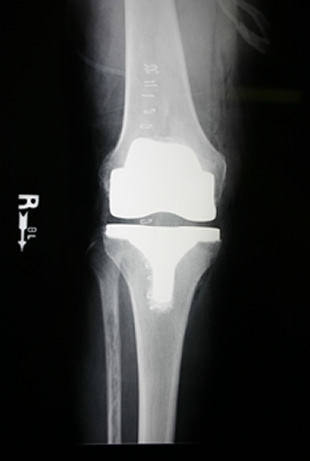 We used to ask patients to come back for a follow-up visit yearly, but most do so well that seems to be “over-treatment”. You should come back once at a year out for an X-ray to detect anything unusual, and then after that you may follow up only as needed. You can expect your knee replacement to last about twenty years, however it may last less or longer in any particular individual. The best explanation for longevity that I have heard is that one knee out of a hundred will fail per year over the long term. That means if one hundred patients had their knees replaced on the same day, 80 would still be happy with their knee function 20 years later. As many as 20 patients over 20 years may have had the knee revised due to a variety of possible failure mechanisms.
We used to ask patients to come back for a follow-up visit yearly, but most do so well that seems to be “over-treatment”. You should come back once at a year out for an X-ray to detect anything unusual, and then after that you may follow up only as needed. You can expect your knee replacement to last about twenty years, however it may last less or longer in any particular individual. The best explanation for longevity that I have heard is that one knee out of a hundred will fail per year over the long term. That means if one hundred patients had their knees replaced on the same day, 80 would still be happy with their knee function 20 years later. As many as 20 patients over 20 years may have had the knee revised due to a variety of possible failure mechanisms.
The most common causes of knee replacement “failure” are:
- Loosening of the cement bond
- Stretching of ligaments with resulting instability
- Infection (0.5% risk)
- Loss of motion (0.2% risk)
- Fracture (0.1% risk)
The good news is that re-do or REVISION Total Knee Replacement has excellent results as well. This is why younger patients are choosing to get their knees fixed sooner. I often say “the next ten years of your life are your best ten years”, and so I am usually optimistic that total knee replacement is the best option for disabling knee arthritis.
Please come in to our office to see us if you have other questions!